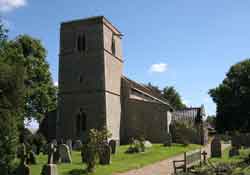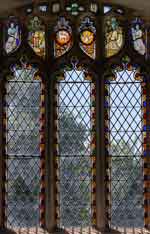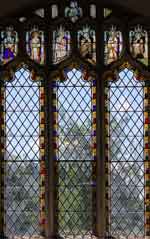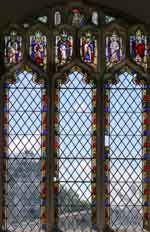Stained Glass of All Saints Church, Weston Longville, Norfolk
 For many this church will be best known for its 18th century association with the renowned Parson Woodforde, however, many of its architectural treasures date from long before his tenure.
For many this church will be best known for its 18th century association with the renowned Parson Woodforde, however, many of its architectural treasures date from long before his tenure.
Architecturally, the tower survives from the 13th century and the chancel from the 14th century. With a plethora of medieval churches across Norfolk these facts are not exceptional. What makes this church so special is its internal decorations namely its screen and wall paintings and to a much lesser extent its glass.
The heavily restored 15th century screen retains both its dado and upper tracery. It is an “Apostles Creed” screen with the dado depicting the 12 disciples (Matthias replacing Judas) all carrying scrolls of the creeds. There are two sets of wall paintings. The first set depicts John the Baptist with John the Evangelist, both distinguishable by their respective symbols of the lamb and poisoned chalice. The second is a fine Jesse Tree (i.e family tree of Christ) wall painting of about 1350 – 1370.
The only remaining stained glass can be located in the tracery lights of three south aisle windows. Some of the figures originate from the 15th century, and include those typical of the Norwich school. However, much of the glass was restored by John Dixon in the 19th century which involved replacing large portions of figures – sometimes in their entirety. The remaining medieval glass includes a figure of St James, which is identical to that found in St Peter Hungate (Norwich) leading David King to surmise that it can be dated to the period 1460 – 1480.
For further information and to view the details of each window click the ![]() boxes below. For a downloadable and printable fact sheet click
boxes below. For a downloadable and printable fact sheet click ![]()



